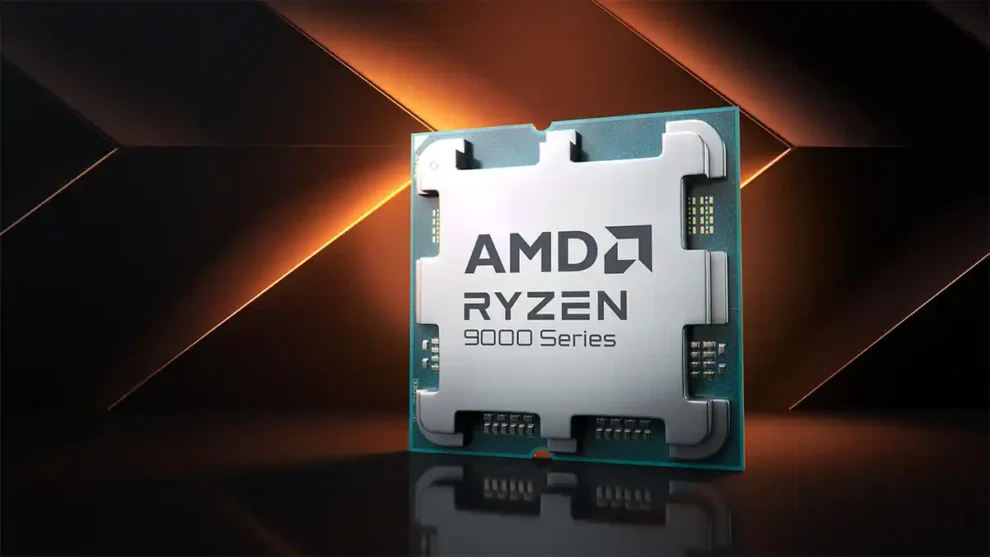The AMD Ryzen 7 9800X3D has been making waves in the gaming world, claiming the title of “gaming champion” with its impressive performance. But what’s going on under the hood? A recent “gutting” of the processor, complete with a blowtorch and some serious determination, has revealed the secrets of AMD’s 3D V-Cache technology. This article delves deep into the die shot analysis, exploring the intricacies of the CPU cores and the revolutionary 3D V-Cache that gives this processor its edge.
In the world of PC gaming, the processor, or CPU, is the heart of the machine. Its performance dictates how smoothly games run and how detailed the graphics can be. AMD, a leading name in the semiconductor industry, has consistently pushed the boundaries of CPU design. Their latest marvel, the Ryzen 7 9800X3D, boasts a groundbreaking technology called 3D V-Cache, which stacks cache memory vertically to significantly boost gaming performance. This article will explore the inner workings of this CPU, thanks to a daring individual who took a blowtorch to their processor to reveal its secrets.
Deconstructing the 9800X3D: A Blowtorch and a Quest for Knowledge
A user on the Chinese video-sharing platform Bilibili, known for their destructive tech explorations, took it upon themselves to dissect the Ryzen 7 9800X3D. Their weapon of choice? A blowtorch. Why? Because AMD uses solder to connect the CPU to the heat spreader, requiring high temperatures to melt and separate the two. This unorthodox method provided a rare glimpse into the chip’s architecture, specifically the CPU cores and the 3D V-Cache.
Die Shot Deconstructed: CPU Cores and 3D V-Cache
The die shot reveals the intricate layout of the 9800X3D. Previous generations of Ryzen X3D CPUs had the 3D V-Cache stacked on top of the Core Complex Die (CCD), which houses the CPU cores. However, the 9800X3D flips the script. The CCD is now on top, sitting directly beneath the heat spreader. This design change improves heat dissipation, allowing for higher clock speeds and better overall performance.
Beneath the CCD lies the star of the show: the 3D V-Cache. This massive 64MB L3 cache is the secret sauce behind the 9800X3D’s gaming prowess. By stacking the cache vertically, AMD has dramatically increased the amount of high-speed memory available to the CPU cores. This translates to faster loading times, smoother frame rates, and an overall better gaming experience.
3D V-Cache: A Game Changer in CPU Design
Traditional CPUs have limited cache memory, forcing them to access slower system RAM more frequently. This can create a bottleneck, especially in games that require rapid data access. 3D V-Cache solves this problem by providing a massive pool of high-speed memory right on the CPU die.
Imagine a library with limited shelf space. To access more books, you’d have to constantly go to the storage room, which takes time. 3D V-Cache is like adding a whole new floor to the library, allowing you to keep more books readily available. This means less time “going to the storage room” (accessing system RAM) and more time “reading” (processing data).
The Impact of 3D V-Cache on Gaming Performance
The results of this innovative technology are undeniable. The Ryzen 7 9800X3D has consistently outperformed its competitors in gaming benchmarks. Games that rely heavily on CPU performance, such as those with large open worlds or complex physics simulations, see the most significant benefits.
For example, in tests conducted by various tech publications, the 9800X3D showed an average of 15% improvement in frame rates compared to CPUs without 3D V-Cache. In some cases, the performance gains were even higher, reaching up to 30% in certain games. This translates to a smoother, more responsive gaming experience, especially at higher resolutions and refresh rates.
Beyond Gaming: The Wider Implications of 3D V-Cache
While 3D V-Cache has undeniably revolutionized gaming performance, its potential extends beyond just gaming. Applications that require high-speed data access, such as video editing, 3D rendering, and scientific simulations, can also benefit from this technology.
Imagine a video editor working with a high-resolution video file. With 3D V-Cache, the editing software can access the necessary data much faster, resulting in smoother playback, quicker rendering times, and a more efficient workflow.
The Future of 3D V-Cache: AMD’s Roadmap
AMD has made it clear that 3D V-Cache is here to stay. They have already announced plans to incorporate this technology into future generations of Ryzen processors, promising even greater performance gains. As manufacturing processes improve and die sizes shrink, we can expect to see even larger and more efficient 3D V-Cache implementations in the future.
This continuous innovation from AMD is pushing the boundaries of CPU design, driving performance to new heights. The Ryzen 7 9800X3D is just the beginning of a new era in computing, where 3D V-Cache plays a crucial role in unlocking the full potential of processors.
The “gutting” of the Ryzen 7 9800X3D, though unorthodox, has provided valuable insights into the inner workings of AMD’s gaming champion. The die shot analysis has revealed the intricate layout of the CPU cores and the revolutionary 3D V-Cache, showcasing the ingenuity behind this groundbreaking technology.
As AMD continues to innovate and refine 3D V-Cache, we can expect to see even more impressive performance gains in the future. This technology has the potential to revolutionize not just gaming, but also a wide range of applications that demand high-speed data access. The Ryzen 7 9800X3D is a testament to AMD’s commitment to pushing the boundaries of computing, and a glimpse into the exciting future that lies ahead.



















Add Comment